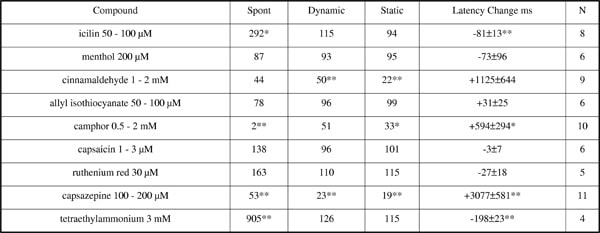Slowly adapting type II mechanoreceptors exhibit a highly regular pattern of interspike intervals when responding to a mechanical stimulus, and often maintain a background discharge of spontaneous firing (Gottschaldt et al., 1973). In order to study the possible contribution of transient receptor potential (TRP) channels in mechanotransduction at the nerve terminals, a range of agonists and antagonists were studied on spontaneous and mechanically evoked responses. Seven adult Wistar-derived rats were used, with a mean weight of 502g. Briefly, each animal was deeply anaesthetized with urethane (2 g/kg) I.P., and then killed. Whisker pads were removed, and individual sinus hair follicles with hair and nerve attached were microdissected out and placed in carbogenated (with bubbled medical 95% oxygen, 5% carbon dioxide) synthetic interstitial fluid (SIF). After slitting a follicle lengthways, it was fixed with insect pins onto a silicone elastomer Sylgard platform in a custom-made tissue bath. The follicle was pinned open to allow easy access of drugs to mechanoreceptors within the capsule. Drugs were made up in SIF and applied at the rate of 1 ml/min. Statistical analyses included t tests comparing effects with control. A total of 17 St II units were recorded. The results are summarized in the table. The broad spectrum TRP channel antagonist ruthenium red slightly increased activity in 2 units, and had no effect on the other 3. Capsazepine, the TRPM8 and TRPA1 channel antagonist, had powerful depressant effects on static and dynamic responses, and less effect on spontaneous firing, so that in some units there was only firing between stimuli. Cinnamaldehyde had its greatest effect on static, and less effect on dynamic and spontaneous. Camphor reduced spontaneous firing most, and dynamic responses least. Icilin increased spontaneous firing, while menthol had inconsistent effects but did significantly enhance cold evoked responses (121±7.2%, t(4) = 6.62, P = .003), Cahusac & Noyce, this meeting. These data suggest that TRP channels play a role in the mechanotransduction processes of slowly adapting type II units.
Life Sciences 2007 (2007) Proc Life Sciences, PC232
Poster Communications: A possible role for transient receptor potential (TRP) channels in mechanically evoked responses from slowly adapting type II mechanoreceptors
P. M. Cahusac1
1. Psychology, Stirling University, Stirling, United Kingdom.
View other abstracts by:
Where applicable, experiments conform with Society ethical requirements.

